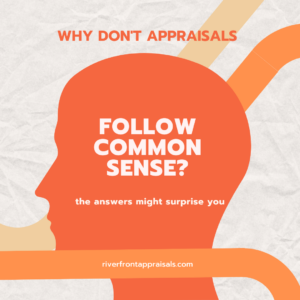
Property Taxes Just Went Up? We’ve Got You Covered!
It’s reassessment season for most folks in our area. Homeowners

For the past couple of years, I’ve been blogging about appraisal topics for various audiences. Most recently, I’ve focused on the homeowner and the loan officer. All throughout 2022, my focus will be on helping Realtors understand a little more about appraisals. Each month, I’ll write about a topic that affects both the appraiser and the Realtor, and how the Realtor can serve their clients better with a deeper understanding of the appraisal process.
In this first installment, I’ll be going over adjustments. This blog post, and those that follow, are not intended to be very deep, scholarly works. We’re just going to scratch the surface, and give our readers a basic understanding here, which will hopefully encourage you to go on and learn more!
[bctt tweet=”Each month, I’ll write about a topic that affects both the appraiser and the Realtor, and how the Realtor can serve their clients better with a deeper understanding of the appraisal process.” username=”RiverfrontApp”]
How appraisers make adjustments in an appraisal report is one of those things that’s always been a hard thing to really get a good grasp on. Why? There are a couple of reasons. First, there are several methods of deriving and applying adjustments, and of those, multiple methods can be used in the same report. Also, some adjustments are merely made up, or applied based on the ‘this is how I’ve always done it’ method. And that’s not helpful to anyone.
So again, I hope to shed some light on this issue, and leave you with a few techniques to use (and one not to) when pricing your next listing. We’ll start with a brief discussion about what adjustments are, and then we’ll look at some of the more commonly asked about adjustments like square footage and market conditions (time) adjustments. Throughout our blog, we’ll be talking about paired data, price per square foot and other methods of adjusting.
What is an adjustment?
In a typical appraisal report for mortgage financing, somewhere (usually around page two or three) there will be a sales ‘grid’. On this grid will be the subject property and several elements of comparison (condition, quality, age, square footage, room count, garages, porches, etc etc). Next to the subject will be comparable sales that have been used to help the appraiser arrive at a value conclusion after making adjustments to the sales. Adjustments can sometimes be made on a percentage basis, or (even more rarely) a qualitative basis (simply stating superior to / inferior to, etc). But most often, they are based on a dollar amount. If a comparable sale has less square footage than the subject, then a positive (+) dollar adjustment will be made to the comparable’s sale price. If a sale has three acres when the subject has only one, then a negative (-) adjustment will be applied to that sale. The goal is to make adjustments to account for differences, which will ultimately bring those comparables closer to what the subject actually is. And, in doing so, these adjustments produce an ‘adjusted’ comparable sale price, which is an indication of the subject’s value. Let’s say the appraiser includes three sales in the Sales Comparison Approach, or ‘grid’. The sales sold for $250,000, $215,000, and $270,000. That’s a big range of sale prices, isn’t it? But after making positive and negative adjustments to these sales, that range should get smaller. Maybe that range narrows to $230,000 – $240,000. This would indicate that the subject’s value is somewhere between $230,000 – $240,000. Since usually the subject and comparable sales are not perfect model matches (though that sometimes does happen), adjustments are made to the sales to bring them more in line with the subject. What the appraiser is telling the reader of the report is “these three homes are similar to the subject, but have some differences. So I made adjustments to them, to make them more like the subject. In doing so, the final range shows me that based on these similar homes that have been purchased, buyers would pay $XX,XXX for the subject property.”
Square Footage Adjustments
At times, I’ll visit a property and there will be an ‘appraiser packet’ on the counter. Some appraisers frown upon this, but I love these packets. They’re nuggets of information that helps me get inside the listing agent’s head and learn a little more about how they priced the home. And, most of the time, there will be a handwritten number on each of the MLS sheets. $127/sf ; $150/sf ; $145/sf. This tells me that the #1 element of comparison used in pricing this home was price per square foot.
Pricing a home using PPSF is only acceptable when the home is brand new or only a couple years old, and you’re comparing it to model matches. If the home is new or newer, and located in a tract subdivision with hundreds of cookie-cutter homes, then you’ll have plenty of sales. You could easily have 6-10 sales all practically identical with the exception of square footage. In this situation, you could extract a median PPSF and apply it to your subject.
However, once the homes start getting older, and more varied in their components, the less reliable PPSF becomes. Let’s say your home is 25 years old and was remodeled 10 years ago. It has three bedrooms and two baths, 2,000 square feet and a partially finished basement. Your sales range from 5-40 years old, 2-4 bedrooms, 1,500 – 2,300 square feet and some have basements while some do not. Still think PPSF is a good idea? That number you calculate (sale price / square footage) includes everything. Design, age, quality, condition. And of course, square footage, bedrooms, bathrooms, interior and exterior amenities and lot size, just to name a few! So while it can be a good starting point, it’s never a good idea to price a home using this method, unless it’s a new/newer home and you have plenty of sales almost identical to the home you’re listing.
Instead, let me give you another method, we call matched pairs. If you can find two sales that are mostly similar in the subject’s neighborhood, then great! Start there. Minor differences usually don’t need to be adjusted for (a few years difference in age, a couple hundred square feet difference in lot size, etc), so don’t worry about not getting identical pairs. But let’s say they are mostly all similar except for square footage. Comp #1 sold for $325,000 and had 2,800 square feet and Comp #2 sold for $375,000 and had 3,200 square feet. The difference in sale price is $50,000 ($375,000 – $325,000) and the difference in square footage is 400 (3,200 – 2,800). What this is telling you is that for an additional 400 square feet, a buyer was willing to pay an extra $50,000. And that works out to be $125/sf ($50,000 / 400).
What you’ll want to do now, is find more of those pairs. If you can find even one more group (more is better), you’ll be able to form a range of adjustments. Maybe you can locate three groups. Even if you have to go down the road to a very similar neighborhood, that’s ok. After you do your analyses, you come up with three numbers for your square footage adjustment. $115, $125, $130. That’s a good range! Your adjustment could be anywhere in that range and you’ll be just fine.
Market Conditions (Time) Adjustments
In markets where values are declining or appreciating (rather than just stable), making proper market conditions adjustments can really make a big difference in your pricing strategy. It’s a simple adjustment, so we won’t spend as much time here, but it’s extremely important you understand how and why to make this adjustment.
For this example, we’ll assume we’re in a hot market that has been appreciating over the past year.
Step 1: Determine your monthly rate of appreciation. I think most Realtors understand how to calculate the rate of annual appreciation, so I won’t cover that, but let’s assume that the annual rate of appreciation is 6%. If you divide that by 12, you now have your monthly rate, which is .5%.
Step 2: Determine the difference between the current month and the comparable sale contract month. If the sale went under contract in May and it’s now September, then four months have passed since the comparable sale contract date.
Step 3: Multiply the monthly rate of appreciation by the number of months in Step 2.
Step 4: Multiply the number you got in Step 3 by the comparable sale price.
Let’s see all of this together.
It’s September. Comparable #1 sold in May for $179,000. Our annual rate of appreciation is 6% and our monthly rate is .5%. Multiply 4 (months) x .5% = 2%. Multiply the comparable sale price of $179,000 x 2% = $3,580. That’s your market conditions (time) adjustment. That means that in the past four months, Comparable #1 has increased in value by $3,580. Another way to look at it is, if that particular home was on the market today in September, it would be worth $3,580 more than when it sold in May due to the increasing market / appreciation. Pretty easy, right?!
Using Sensitivity Analysis
Numbers aren’t everything. Sometimes, you just need to trust your gut. Your experience. Your knowledge of the market. Sometimes you need to challenge the numbers. Let’s say your research indicated a range of garage bay adjustments from $3,000 – $10,000 and you applied a $4,000 adjustment. But at the end, you’re left with a range of adjusted comparable sale prices that is a bit larger than you’d like to see. What if your adjustment wasn’t large enough? Try increasing your garage bay adjustment to $8,000. Does that bring the sales more in line with each other? Does the range of adjusted sales decrease? If so, that may be an indication that your original adjustment was too low. This is what we call sensitivity analysis. The first step is determining an adjustment, and then following that up with some common sense and fine tuning. Sometimes the numbers are spot on, but sometimes they just need a little help. Master this, and you’ll be better at pricing than the majority of Realtors in your market (and some appraisers!).
Does Everything Require an Adjustment?
You just secured a new listing and have begun your search for comparable sales so you can price the home. While looking through the MLS, you notice some differences between the subject and the sales. One has a pool, another has 100 square feet more than your home, one has hardwood floors throughout and yours has new laminate flooring. Do you need to adjust for all of these features?
Maybe. Maybe not.
Remember those bracelets that half of the country wore a couple decades ago? WWJD? What Would Jesus Do? Yeah, I may or may not have had one of those. Well, appraisers have to ask WWTMD? What would the market do? Would a typical buyer pay more for 100 square feet when the homes are 4,500 – 5,000 square feet? Would a buyer pay more for a home with an inground pool? And the way we determine that is by looking at homes in the market that have sold. We’re not just making this stuff up. There’s evidence out there. And it’s easy to find.
Is your home in a neighborhood where 90% of the other homes have a pool? Do you have sales to prove that homes with pools sell? Then If your home doesn’t have a pool, that may be a negative factor and you’d want to adjust for that.
Are your buyers so savvy that they can walk into a 4,300 square foot home first, then tour a 4,200 square foot home and say “oh, this home is 100 square feet smaller. I can tell. And I’m not paying as much for this house as I would for that first one.” I seriously doubt it. So maybe an adjustment for such a small difference is unnecessary.
Does your subject have a large shop in the backyard, but the home is in the middle of town on a 7,500 square foot lot and no other homes around have a shop? Maybe that shop is an over-improvement for your market segment. If you can’t find evidence that other buyers have paid for homes with shops, then an adjustment may not be necessary. Appraisers are analyzing market reaction when applying adjustments and just because a home has X amenity, doesn’t always mean it makes the home worth more.
Are All Adjustments the Same Everywhere?
How many times have you asked an appraiser “What’s the adjustment for a garage bay?” Or, ‘How much do you adjust for bathrooms?” Oh, if it were only that easy! If I’m asked that question (and I am.. A lot), my answer is always “it depends”. It’s not the answer Realtors want to hear, but it’s true. And here’s why: It depends on the market segment. Although some appraisers will whip out their handy adjustment sheet that they use on every appraisal every time, this isn’t proper appraisal practice. And I don’t suggest it for you. Consider two completely different subdivisions in your hometown. One is an older neighborhood with homes ranging from $80,000 – $120,000. These homes are roughly 30-50 years old and are usually between 900 – 1,300 square feet in size. After completing your research and analyses, you determine the following adjustments should be applied to your new listing in this neighborhood:
Square footage: $50/ft
Bedroom: $0 (no adjustment necessary)
Full Bathroom: $4,000/bathroom
Garage Bay: $3,000/bay
Now, consider another neighborhood just a mile down the road. Homes in this subdivision usually sell between $190,000 – $300,000, are between 5-15 years old and typically have between 2,000 – 3,000 square feet.
Should the same adjustments be made to homes in this neighborhood?
Not likely.
I mean, sure – anything is possible, but I’ve never used the same adjustment for a $100,000 house that I did for a $300,000 house. Perhaps in this market, bedrooms actually do make a difference. If you didn’t adjust for bedroom count, you’d be making a big mistake. And what if in this neighborhood, you’re looking at a comp which is only 5 years old, and cost $275,000 to build at a price per square foot (when new) of $125/ft. Adjusting this home at only $50/ft doesn’t really make much sense.
What about different designs? Would you adjust a manufactured home’s square footage at the same rate as a site-built, brick two-story home? Never! I’ve been able to extract some really low square footage adjustments for manufactured homes that if I applied to a traditional Ranch-style home, I’d be crucified!
Conclusion
The next time you get a new listing, I challenge you to really look hard at the sales, how they differ or how they are similar to your subject. Try your hand at one of the techniques briefly discussed here and sure – even if you want to – go ahead and figure PPSF. But only as one possible indication of value. Remember that not all elements require an adjustment, so look into the market to see what buyers have been doing. Let the sales speak for themselves! Also, don’t apply that bathroom adjustment you got from your last $120,000 listing on your new $500,000 listing. And finally, if you’re in a bind, or are having trouble calculating an adjustment, call an appraiser! This is what we do multiple times each day, and most appraisers enjoy explaining these things to Realtors. If you don’t have an appraiser you know well and can trust to give you reliable information, start making calls and meeting new appraisers. I guarantee it will help your business. But that’s next month’s blog. So stay tuned!
Committed to helping you understand your home’s market value,
Ryan Bays, SRA, AI-RRS

It’s reassessment season for most folks in our area. Homeowners

I feel like we all need a laugh. How about

So this may be a slight break from the norm,
Riverfront Appraisals has been providing comprehensive valuations of residential properties to Western Kentucky and Southwestern Indiana since 2008.